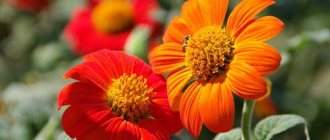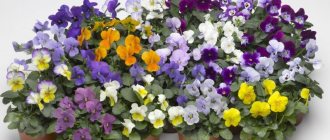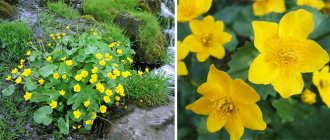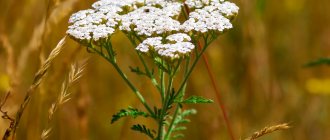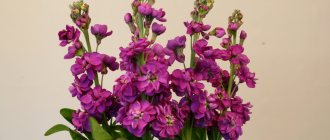Description of the common loosestrife
The common loosestrife plant grows up to 1 m. Its stem is simple, erect, branched at the top, and pubescent.
Side shoots form a lush bush
The leaves are lanceolate or ovate, their edges are even, the surface is smooth. The length of the leaf reaches 10 cm, width - 4 cm. The bottom of the loosestrife leaf is slightly pubescent. It is similar in shape and color to a willow leaf, which is where the name of the culture comes from. The leaves are arranged oppositely on the stem in several pieces.
The flowers are bright yellow, medium-sized, five-parted, their diameter does not exceed 1.5 cm. There are also five stamens inside the inflorescence. The budding period lasts all summer, from early June to late August. The flowers form paniculate inflorescences along the entire length of the stems.
Flowers growing in bright sunlight, large, cross-pollinated
A bush grown in the shade blooms with small self-pollinating inflorescences. Its green part does not suffer from lack of light.
The fruits appear in August and are a spherical capsule. It produces small and light-colored seeds. The roots are creeping, their shoots are long, located deep underground.
Where does it grow
Common loosestrife grows in a humid environment, preferring the proximity of water bodies.
Wild common loosestrife has thin small leaves, small flowers are located only at the ends of the shoots
In Russia, the plant can be found in the European part, Western and Eastern Siberia, and the Caucasus. In the world, the culture is widespread in Eurasia, excluding the Arctic, and North Africa.
Chemical composition
The juice of loosestrife leaves (lysimachia vulgaris) contains a large amount of vitamin C, up to 260 mg of the total amount. The leaves, stems and rhizome contain flavonoids, tannins, silicic acid, saponins, and the enzyme primverase.
Popular types of proud flower
For some summer residents, the proud “master of the flower kingdom” - loosestrife - is one of the favorites of landscape design. The plant is especially valued for the abundance of different varieties that grow freely in Russia. Taking a close look at the majestic flower, you can notice the many shapes and shades that are inherent in different varieties.
Common loosestrife
This pretty plant has a tall, straight stem. It is not covered with bark and has no branches. From the horizontal climbing rhizome, erect shoots rise upward in huge numbers. Most often, flowers reach 50 cm, and some giants grow up to a meter in height. Whorled foliage grows along the entire stem of the common loosestrife from bottom to top. It comes in a narrow shape with pointed tips. The lower leaves are colored light green, the upper ones are more saturated with greenery. Some specimens are distinguished by a scarlet tint of leaves.
At the very top of the erect stem there are paniculate inflorescences. Each of them is decorated with cute flowers located close to each other. The buds consist of five separate delicate petals that surround a corolla with an ovary and stamens. As a rule, the inflorescences are yellow, although orange, burgundy and snow-white varieties are also found. The plant blooms in summer, after which balls with a large number of seeds appear instead of buds.
Common loosestrife has medicinal properties. Tinctures or decoctions from it are used as a tonic and anti-inflammatory agent. It is often used as an astringent and choleretic natural substance.
Monetary loosestrife (coin type)
The plant belongs to the family of perennial herbs. It has creeping horizontal stems about 80 cm long. The shoots of the coin loosestrife are erect, slightly branched. Nodules appear on them, on which small roots grow. Thanks to them, the plant successfully grows throughout the area. Loves fertile soil and shady places. In nature, it is found in the shade of low bushes, in wet meadows or on the outskirts of swampy areas.
The leaves of the loosestrife are opposite, slightly rounded in shape. Their edges are solid and green in color. The buds grow in the axils of the leaf blade. They are usually large in size and solitary. The color is golden yellow, the calyx is funnel-shaped, the petals are not connected to each other. Flowering period is mid-summer.
Monetary loosestrife loves shaded areas of the garden and fertile soil. Having fulfilled only these two requirements, you can already achieve success in growing this plant.
Loosestrife point
The flower of this variety is distinguished by a brown rhizome, which has several branches. Shoots emerge from them underground. Thanks to this, the plant grows wonderfully throughout the front garden.
The erect stem of the dotted loosestrife has a delicate edge. Unlike other species, the shoots have several branches. Along each of them there are wide lanceolate leaves, lemon or yellow buds located in large numbers along the dense stem.
Loosestrife lily of the valley
The name of the plant hints that in appearance it resembles lilies of the valley. And indeed it is. Lily of the valley loosestrife has a stable, dense stem, on which alternate leaves are located from bottom to top. They are slightly bluish below and dotted with small dots on top. During flowering, the plant puts on spike-shaped buds consisting of many small flowers. They are painted snow-white and sit at the very top of the stem. The flower grows up to 45 cm and fits beautifully into any landscape design.
Loosestrife
This variety of loosestrife is often called lily of the valley, due to the similarity of its underground rhizome with it. It has the same pinkish-white color, but is slightly thicker than lily of the valley. The loosestrife has an erect stem (about 20 cm in height), covered on all sides with foliage. The inflorescence is collected in a dense spike, filled with many white buds. It blooms in mid-summer and pleases the eye for 3 weeks.
Loosestrife clethroides
This type of plant is also classified as a lily of the valley variety of loosestrife. The flower grows up to 80 cm in height. Opposite round leaves grow on its tall, dense shoots. Loosestrife clethroides blooms with snow-white spike-shaped buds. From a distance it resembles the original green bushes in the white robe of the bride. They are used to decorate personal plots: they are planted as living borders on lawns, in alpine hills and near the shores of artificial pools.
Purple loosestrife (ciliate)
This perennial plant forms miniature bushes with erect stems. All of them are covered with smooth lanceolate leaves of wine-red color. Purple loosestrife is famous for its original inflorescences, which are located on the tops of slender shoots. The buds are collected in small bouquets that shine lemon-colored in the sunlight. The flower loves open, light areas with moist, fertile soil.
Often, ciliated loosestrife grows up to 45 cm in height, which gives it a majestic appearance. The plant begins to bloom at the end of August and can continue until mid-September. It is not afraid of harsh winters, as it is considered a frost-resistant variety. In its natural environment it is found in wet meadows near water bodies.
I would especially like to highlight the original ciliated variety - firecracker loosestrife. It can grow up to a meter in height, which looks pretty nice against the backdrop of other greenery. Erect shoots are alternately covered with lanceolate leaves pointed at the tips. Inflorescences appear in the axils of the leaf blades at the top of the shoot. The bluebell buds are bright yellow and bloom in early autumn. They bloom until October. Frost-resistant. They feel comfortable in the open areas of the garden.
Loosestrife Beaujolais
This delightful perennial grows up to a meter in height and is distinguished by unusual inflorescences. They are colored dark red and collected in dense ears. Beaujolais loosestrife has silvery-green lanceolate leaves that are slightly ruffled at the edges. They go wonderfully with the dark buds that appear during flowering. The plant prefers fertile soils that retain moisture for a long time. They are widely used to decorate summer cottages. Planted to mark the territory instead of borders.
Verbeinik Alexander
This stately herbaceous perennial grows from 40 to 50 cm in height. Its erect stems bear sessile, broadly lanceolate leaves. Along the entire shoot, in mid-summer, many delicate flowers appear. They are collected in small bouquets and shine brightly with lemon color against the background of the dense greenery of the plant. Loosestrife Alexander feels luxurious on fertile land, where there is a lot of air and light. He is especially comfortable in combined plantings of flowers near bodies of water. Loosestrife is often used to create mixborders that bloom continuously until late autumn. It is in such an environment that he looks like the ruler of the kingdom of flowers.
Before designing a flower garden, you should take into account the property of this variety to grow quickly. Otherwise, loosestrife will crowd out weak plants, which will disrupt the overall harmony of the flowerbed.
Reproduction
Common loosestrife grows as a weed everywhere in the wild. The crop propagates by seeds, which are carried by the wind, and self-seeding occurs.
Common loosestrife can also be propagated in a flower bed using seeds.
The seed is pre-stratified and then sown in open ground in the spring. The seedling will flower 3 years after rooting.
Plants grown in flowerbeds are propagated by dividing the bush, shoots or cuttings. With this method of propagating the crop, flowering occurs the next year after planting.
Propagation of a perennial plant
This plant can reproduce vegetatively and by seeds. The vegetative method involves separating a shoot from the mother bush, germinating cuttings or picking root descendants. The vegetative method is simpler and faster, which is why gardeners really liked it.
When grown with grains, the seedling is formed 2-3 years before flowering begins; when planted using the vegetative method, it can bloom in the coming year.
How to sow loosestrife for seedlings
When it is necessary to plant seeds, the planting material should be prepared in advance.
One of the important procedures is stratification, which includes hardening the grains in the refrigerator at a temperature of 8 -10 degrees for one to two months. Then you should prepare a small box or containers, cups with drainage holes and, filling the containers halfway with a mixture of peat and sand, sow the seeds.
The seeds are quite small, it is worth spending more of your time to scatter them over the surface as little as possible, ideally keeping a space of 2-3 cm between them. Gently sprinkle the soil mixture on top, which will cover the seeds by 0.5-1 cm.
After this, the containers are covered with film or glass and placed in a bright, warm place (window sill). After 2 weeks, shoots form, the cover is immediately removed so that the plants do not become ill with putrefactive diseases. The first 2-3 full leaves are a sign to start picking. The plantings are transplanted into the most free containers; you can use the same fork to “dig” them out of the ground without damaging the roots.
Approximately 5–7 days after picking, you can begin to gradually strengthen the seedlings. We take it out into the fresh air, leaving it first for an hour or two, then for half a day and then for a whole day. Hardened seedlings are planted in open ground, the approximate distance between seedlings is 40–50 centimeters.
If you sow seeds in open ground, then this should be done in the fall in deliberately prepared soil. After sowing, cover the ground with leaves “under the snow”; in this case, the seeds are certified in a natural way. In May, the grown plants will be ready to be transplanted to a permanent location.
Reproduction by dividing the bush
One of the very effective methods of propagating a plant is to divide the bush into several shoots. The bush is uprooted, trying not to spoil the roots, and the regrown shoots are separated.
Why divide the main bush in this way so that each has a separate developed root. After which all separated parts of the bush are planted. Bushes planted in this way are accepted immediately and can bloom next year. Caring for transplanted bushes is the same as for an adult plant.
Propagation by cuttings
Loosestrife is best propagated by cuttings, which are cut from the stepsons of the main stem, 10 - 20 cm long. Stems for cuttings are pruned during spring or autumn thinning of the bush. In order for the cutting to take root, it is enough to immerse it in water for several days. After the roots appear, the cuttings can be planted in open ground, choosing a place in partial shade.
Planting and caring for common loosestrife
Common loosestrife is a moisture-loving crop. If you create all the necessary conditions for it, it will quickly grow and bloom.
Deadlines
It is recommended to plant common loosestrife in the ground in warm autumn - in September or early October. Also, the seedling will be well received in late May or early June. You cannot root common loosestrife before winter or early spring; the young plant does not tolerate frosts.
Landing algorithm
To root common loosestrife, choose shaded areas with well-moistened soil. This condition is the main thing for the rapid establishment of loosestrife.
Before planting, an adult plant is dug up and its root is divided into 2 or 3 parts.
The procedure is carried out even if there is no need to propagate loosestrife
The crop must be replanted every 2 or 3 years to rejuvenate the bush.
How to plant:
- The planting area is dug up and the ground is carefully loosened.
- The soil is mixed with compost or humus.
- After dividing the bush, dig holes.
- A thin layer of crushed stone is placed at the bottom, since common loosestrife needs good drainage.
- The planting hole is filled one third with water, waiting for it to be completely absorbed.
- The rhizome of the plant is placed in the hole, crushed with well-fluffed soil, and lightly compacted.
In loose soil, the root system of the plant develops well.
After planting, the common loosestrife is watered abundantly.
Planting loosestrife in open ground
When to plant
Loosestrife can be propagated by seeds and vegetative methods. Sow loosestrife seeds in the ground in June or September, before winter.
- Turkish cloves: growing from seeds, planting and care
Almost all types of loosestrife grow best in shade or partial shade, and coin loosestrife, although it prefers the shade of trees, feels great in the sun. And only purple loosestrife prefers open sunny places.
How to plant
Loosestrife needs fertile, loose and moist areas with close groundwater, and species such as loosestrife, loosestrife, and common loosestrife can simply be planted in a reservoir to a depth of 10 cm. The composition of the soil for loosestrife is not of fundamental importance; it does not like only clay soils. Loosestrife is planted in soil fertilized with well-rotted manure or compost.
Loosestrife is planted like any other plant: the root system is placed in a hole, after which it is covered with soil, the surface of the area is compacted and watered. The distance between loosestrife bushes should be at least half a meter.
Necessary care
After transferring to a new place, common loosestrife is quickly accepted and does not require special care. For good growth and abundant flowering, you should follow a number of recommendations for caring for the plant.
Watering and fertilizing
The plant does not need frequent watering, as it is planted in damp areas of the ground, in the shade. If the summer is dry and there is no rain for a long time, watering is carried out approximately once a week, as necessary. Approximately 2 liters of water are poured under the root of each seedling.
If common loosestrife grows on depleted soils, it needs fertilizing. They are introduced starting at the end of May. Fertilize the plant no more than once every 2 weeks. To do this, dig up the soil around the bush with humus and water it.
Weeding and loosening
The crop grows well and does not lose its decorative qualities in clean areas without weeds.
In group plantings with common loosestrife there should be no extra (weed) plants that will disturb the composition
Weeds are removed from the roots as they grow. It is important to ensure that weed seeds do not spill during the weeding process.
Periodically, the soil around the main stem is loosened. It is best to carry out the procedure after watering so that the water does not stagnate at the root. Common loosestrife tolerates waterlogging well, provided there is drainage and air access to the rhizome.
Preparation for winter and pruning
As soon as the common loosestrife fades, it is pruned. The entire above-ground part of the plant should be removed, leaving a stem length of several centimeters. Dry shoots need to be cut off.
The soil around the plant is dug up, you can add humus and thoroughly grind it with the ground. Common loosestrife does not need shelter; it tolerates frost well. In the northern regions, in autumn the plant can be covered with fallen leaves.
Types and varieties of loosestrife with photos
According to various sources, 150-200 varieties of this plant are found in nature. Not all of them are decorative, so we will focus on the most spectacular and in demand in landscape design.
Loosestrife
A European species that grows in damp and fairly dark places - along the banks of reservoirs, mixed forests, up to the subalpine mountain belt. The stems are unbranched, creeping, rising in height by no more than 10-40 cm. It has leaf blades that are larger and wider than those of other varieties. Flower buds are single, yellow in shade, on high stalks. Flowering time is May-July.
Loosestrife
An erect species with spectacular tall spike-shaped inflorescences that can be thrown up to a height of 120cm. Flowers in a white and yellow palette, collected in a spike that is slightly curved at the top. Flowering is medium long, up to 3 weeks. One of the species most often found in culture.
Monetary loosestrife
It belongs to the ground cover perennials and has a relatively short ampelous stem. It forms a dense living carpet and is capable of growing both on horizontal and fairly steep inclined surfaces. Spectacular “sags” form on steep walls. The flowers are yellowish, axillary, arranged singly.
Loosestrife point
Loves moist, shady forests and is found everywhere in Western Europe. Perennial species with erect shoots up to 60 cm high. The root goes up to half a meter to a depth, where it sends out underground shoots that form a whorl. Thanks to this, new shoots appear at the planting site next year, and the planting naturally thickens. Flowering is relatively long, up to 35 days, the flowers are light lemon yellow.
Loosestrife ephemerum
Native to the southwestern regions of Europe. A perennial species with tall, up to 90 cm, erect stems. A distinctive property of this loosestrife is its tendency to grow extensively in width, as can be seen in the photo. It begins to bloom towards the end of summer, the inflorescences are spike-shaped, the flowers are small, 1 cm in diameter. Withstands temperatures down to -19C without shelter.
Diseases and pests
Common loosestrife is a wild crop that is resistant to diseases and pests. Its habitat is damp places; common loosestrife is not afraid of fungal diseases and rot.
Growing in a flower bed or garden, it can be attacked by aphids or weevils.
Insects suck out the juices of the plant, it turns yellow and withers
The presence of pests can be determined by yellowing, eaten leaves. Modern insecticides will help you cope with harmful insects.
If the use of chemicals in the garden is not permissible, weevils are collected by hand.
Harmful insects do not like sunlight and appear on the leaves of the plant in the evening
After the sun's activity decreases, the weevils are thrown into a bucket and destroyed.
What type of loosestrife to choose
Such a simple and unpretentious flower can decorate any place in the garden. You just need to choose your favorite type of plant. A photo of loosestrife will help with this. They present the most popular varieties with their characteristics.
Experienced gardeners recommend two favorite types of loosestrife, widely used for creating flower beds: ordinary and coin.
Common loosestrife is a perennial plant that grows both in nature and is often grown in flower beds.
It is a bush of vertical stems reaching one meter. The leaves are oval-shaped, sometimes with a wavy edge or narrow, wide. The flowers are yellow, shiny, red-brown at the base of the corolla. Inflorescences are paniculate in shape.
Loosestrife blooms from June to August, attracting insects for pollination. It loves partial shade and shade and looks good under trees. The soil should be moist and loose. Grows well in shallow water.
Coin loosestrife, or meadow tea, loves moisture too much; it grows best near bodies of water, on the banks of a river, where the soil is saturated with moisture.
Like all loosestrife, it is perennial, with a thin climbing trunk up to 40 centimeters. The shoots are creeping, branch poorly, and take root on their own. They can densely cover both a horizontal surface and a vertical steep slope.
The leaves of meadow tea are round, shiny, light green, like coins. They are arranged in pairs. The flowers are small, yellow or orange, star-shaped, solitary, growing in the axils of the leaves.
The beginning of flowering depends on the lighting. In the wild it blooms all summer, and in the garden from June to August.
Meadow tea can successfully replace a lawn in the garden; it perfectly covers walls and stones, and looks beautiful in hanging containers.
Medicinal properties and contraindications
Common loosestrife has a number of medicinal properties: astringent, hemostatic, choleretic, analgesic, anti-inflammatory, wound healing. Due to its high vitamin C content, the herb effectively treats scurvy.
Externally, a decoction of common loosestrife is used as an application for bruises, skin inflammation, and as a rinse for gum disease. The herb is also effective for rheumatism, general weakness, and jaundice. The juice of the plant is used as a hemostatic agent on open wounds.
Preparations based on common loosestrife have a number of contraindications:
- they are not prescribed to children under 14 years of age;
- not for people suffering from varicose veins or heart disease;
- contraindicated for pregnant and lactating women;
- not prescribed for diseases accompanied by a dry cough.
Atherosclerosis and increased blood clotting are also contraindications to taking decoctions based on loosestrife.
Features of loosestrife
The herbaceous plant loosestrife can be annual, biennial or perennial. Shoots can be creeping or erect, and simple, entire, alternate leaf blades can be opposite or whorled. Flowers can be part of corymbose or spike-shaped panicles, or be single axillary. They are painted yellow, white or light pink. The fruit is an ovoid or spherical capsule.
Loosestrife is considered a relative of such crops as milkweed, primrose, cyclamen and ambilanthus. This plant is distinguished by its unpretentiousness and, despite the fact that it does not have a very impressive appearance, it is quite popular among gardeners. The fact is that such a crop blooms very luxuriantly and for a long time.
Unpretentious plants for the garden Loosestrife dotted, etc. Website "Garden World"
Use in folk medicine
For colds and runny nose, brew tea with dry loosestrife herb.
Raw materials are prepared in the summer or purchased at the pharmacy
A tablespoon of dry herb is steamed with a glass of boiling water and left for 15 minutes. They drink the product like tea with honey as a bite.
For debilitating diarrhea accompanied by weakness, prepare an infusion: 1 tbsp. l. dry herbs are steamed with a glass of boiling water, wrapped in a towel, and left for 3 hours. The strained infusion is taken warm, 2 tbsp. l. 4 times a day on an empty stomach.
For scurvy and anemia, use fresh plant juice. They drink it 1 tsp. 4 times a day before meals. For these purposes, an infusion is also used: 1 tsp. dry herbs are poured with a glass of hot (not boiling) water and left for 2 hours. The drug is taken 50 ml three times a day on an empty stomach before meals.
For gum disease, common loosestrife is prepared as follows: 2 tbsp. l. dry herbs, pour 200 ml of boiling water, cook for 2-3 minutes.
For gum disease, use a cooled, strained decoction.
Rinse the mouth with the medicine in the morning and evening.


